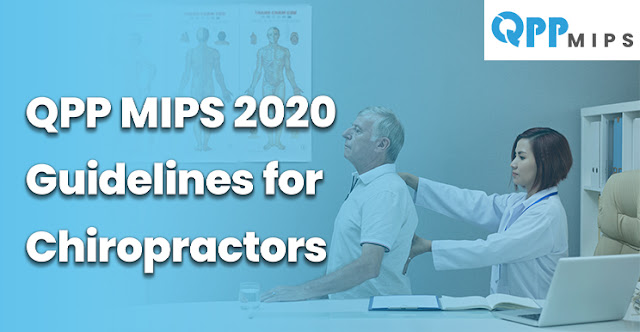QPP MIPS 2020 Reporting Guidelines for Chiropractors Reporting Services

QPP MIPS is a payment model that CMS (the Centers for Medicare & Medicaid Services) has established for high or reasonable performers in the healthcare industry. Eligible Medicare clinicians can report their data that translates quality healthcare, improvement activities, and interoperability while keeping the cost factor in control. General Surgery Billing Services
This payment program rewards physicians with positive payment adjustment, incentives, bonuses, and gives a penalty to those, who don’t meet even the basic performance threshold.
All participants must familiarize themselves with the deadlines and reporting criteria to maximize revenue in the end. There are many MIPS submission methods through the reporting process. However, the most preferable method by hospitals, clinicians, and groups is MIPS Qualified Registries.
Updates Related to MIPS 2020

Every year, CMS modifies some of its rules to accommodate changes or to reduce the administrative burden on physicians. On November 1, 2019, some updates were also released for the performance year 2020. New specialty sets were introduced including chiropractic medicine as part of the quality performance category.
Other updates are:
- Data completeness constraint is raised to seventy percent.
- The performance or penalty-free threshold is raised to forty-five points.
- Cost (15) and quality (45) performance categories have the same points as 2019.
- Moreover, MIPS Value Pathways (MVPs) has also been proposed that refers to the conceptual participation framework. It works to increase understanding and collaboration among physicians and offers measures that align more with the expertise of medical practice.
Given below are the measures that chiropractors can use to report their performance for MIPS 2020.
Quality Performance Category

Eligible physicians have to report 6 measures with one Outcome or High Priority measure for 12 months. Report at least one eligible case to earn 1 or 3 points on a measure. For more than 3 points on a measure, physicians can report at least 60 percent of eligible cases.
Some of the reporting measures for this category are:
- #182 Functional outcome assessment
- #131 Pain assessment prior to initiation of patient therapy and follow-up
- #218 Functional Status Change for Patients with Hip Impairments
- #219 Functional Status Change for Patients with Lower Leg, Foot or Ankle Impairments
- #220 Functional Status Change for Patients with Low Back Impairments
- #222 Functional Status Change for Patients with Elbow, Wrist or Hand Impairments
- #223 Functional Status Change for Patients with General Orthopedic Impairments
- #221 Functional Status Change for Patients with Shoulder Impairments
- #217 Functional Status Change for Patients with Knee Impairments
Promoting Interoperability (PI)
Total points: 25 of the total MIPS scoreEligible chiropractors are required to report all required measures for a minimum of 90 days. 2015 Edition certification must be in place by October 3, 2019.
Some exclusions are available for all eleven reporting measures. Physicians can check their eligibility status on QPP MIPS official website https://qpp.cms.gov/participation-lookup. If physicians are unable to report for this category, the score will be re-weighted to the quality category.
Some of the reporting measures for this category are:
- e-Prescribing
- The query of the Prescription Drug Monitoring Program (PDMP) (optional)
- Provide Patients Electronic Access to Their Health Information
- Support Electronic Referral Loops by Sending Health Information
- Support Electronic Referral Loops by Receiving and Incorporating Health Information
- Immunization Registry Reporting
- Syndromic Surveillance Reporting
- Electronic Case Reporting
- Public Health Registry Reporting
- Clinical Data Registry Reporting
Improvement Activities (IA)
Total points: 25 of the total MIPS scorePhysicians should report 2 high-weighted activities or 4 medium-weighted activities for a minimum of 90 days. Groups with 15 or fewer participants or if you are in a rural area or health professional shortage facility, you can report 1 high-weighted or 2 medium-weighted measures for a minimum of 90 days. Neurology Billing Services
A total of ninety possible measures are available to choose from.
Some of the reporting measures for this category are:
- IA_EPA_3 - Collection and use of patient experience and satisfaction data on access (medium-weighted).
- IA_BE_14 - Engage patients and families to guide improvement in the system of healthcare (medium-weighted).
- IA_CC_8 - Implementation of documentation improvements for practice/process improvements (medium weighted).
- IA_CC_2 - Implementation of improvements that contribute to cohesive communication of test results (medium-weighted).
- IA_BE_16 - Evidenced-based techniques to promote self-management into usual care (medium-weighted).
- IA_BE_17 - Use of tools to assist patient self-management (medium-weighted).
- IA_BE_21 - Improved Practices that Disseminate Appropriate Self-Management Materials (medium-weighted).
- IA_AHE_1 - Engagement of new Medicaid patients and follow-up (high weighted).
- IA_EPA_1 - Provide 24/7 access to clinicians/groups who have real-time access to the patient’s medical record (high weighted).
- IA_AHE_3 - Promote Use of Patient-Reported Outcome Tools (high weighted).
For further details on QPP MIPS data submission, contact - https://qppmips.com/ | (888) 902-1035
The Quality Payment Program (QPP) under the Medicare Access and CHIP Reauthorization Act (MACRA) includes the Merit-based Incentive Payment System (MIPS). Chiropractors participating in MIPS must understand the 2020 reporting guidelines to ensure compliance and maximize their reimbursement potential.
Overview of MIPS
MIPS aims to improve healthcare quality by tying reimbursement rates to performance. Chiropractors can earn positive adjustments to their Medicare payments based on their scores in four performance categories: Quality, Improvement Activities, Promoting Interoperability, and Cost.
Performance Categories
1. Quality
- What It Is: This category assesses the quality of care provided to patients.
- Requirements: Chiropractors must report on at least six quality measures, including one outcome measure.
- Reporting Options: Measures can be reported through claims, a qualified registry, or EHR systems.
2. Improvement Activities
- What It Is: This category rewards practitioners for engaging in activities that improve clinical practice.
- Requirements: Chiropractors need to attest to completing at least two improvement activities for a minimum of 90 days.
- Examples: Activities may include patient safety initiatives, participation in clinical data registries, and implementing care coordination practices.
3. Promoting Interoperability
- What It Is: Focuses on the use of technology and electronic health records to improve patient care.
- Requirements: Chiropractors must use certified EHR technology (CEHRT) and report on specific measures, such as patient electronic access and health information exchange.
- Importance: This category emphasizes the need for secure, efficient data sharing among healthcare providers.
4. Cost
- What It Is: This category measures the total cost of care provided to patients.
- Requirements: While there are no specific reporting requirements, chiropractors will be assessed based on Medicare claims data.
- Key Point: Efficient care delivery can positively influence performance in this category.
Conclusion
Understanding the QPP MIPS 2020 reporting guidelines is essential for chiropractors aiming to optimize their Medicare reimbursement. By actively participating in quality improvement activities and utilizing technology, chiropractors can enhance patient care while securing their financial future under Medicare.
Labels: CMS, healthcare industry, Medicare & Medicaid Services, MIPS 2020, MIPS Qualified Registries, MIPS submission methods, QPP MIPS, QPP MIPSMIPS 2020




